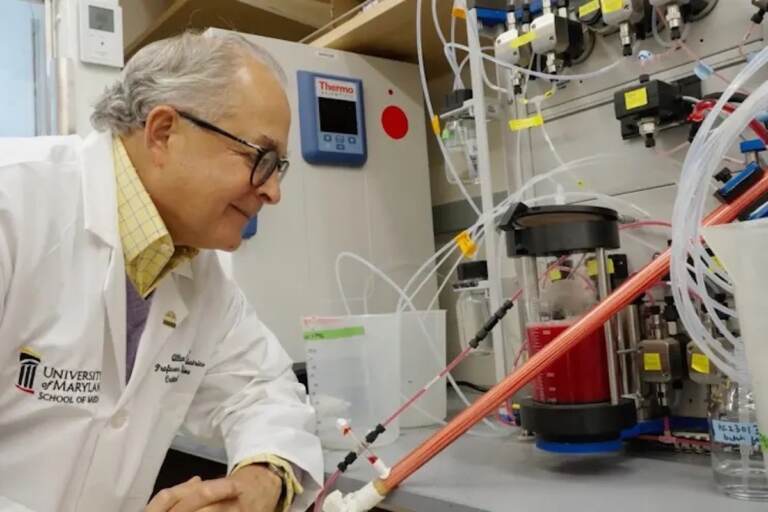A Race to Create Artificial Blood

Dr. Allan Doctor in his lab at the Center for Blood Oxygen Transport and Hemostasis at the University of Maryland School of Medicine in Baltimore. (Courtesy of University of Maryland School of Medicine)
Baltimore Lab Leads Efforts to Reshape Trauma and Wound Care
Published on WHYY | August 1, 2023
In a small, windowless lab room, the temperature reads a chilly 40 degrees Fahrenheit. Loud machines hum away and a reddish liquid flows through clear tube-like columns that reach up toward the ceiling.
The reddish liquid is human blood.
“We start with hemoglobin,” explains Dr. Allan Doctor. “We get that from expired units of blood that the shelf life timed out and they can’t be given to people.”
Hemoglobin is a protein in red blood cells that carries oxygen to the body’s tissues and organs.
Doctor, a professor of pediatrics and bioengineering, points to the clear columns attached to a machine.
“This allows us to separate just the hemoglobin from the broken cells. We purify it and collect it into basically a bottle like this,” he says, holding up a jar.
Down the hall in a medium refrigerator, other bottles and beakers of various sizes hold different amounts of liquid — some a dark, ruby red, others a lighter shade of strawberry.
The scientists and researchers at the Center for Blood Oxygen Transport and Hemostasis (CBOTH) at the University of Maryland School of Medicine in Baltimore are hoping to succeed where others have failed: creating an artificial blood substitute that can be freeze dried, stored at room temperature, and used in an instant out in the field when donated human blood is in short supply or altogether absent.
Project leaders said they hope artificial blood will reshape wound care and prevent uncontrolled bleeding, the most common cause of preventable deaths in trauma.
“What we need is something that’s shelf-stable,” said Doctor, director of CBOTH. “Something that is durable and can be used in an ambulance so that it won’t be ruined if you take it out of the refrigerator for a few hours.”
Every two seconds, a person in the United States needs donated blood and platelets, according to the American Red Cross. But only about 3% of Americans make donations in a given year.
Donated blood has to be kept cold. Once it’s taken out of the fridge, it has to be used within a few hours, or it will expire. And even in perfect conditions, donated human blood only lasts for about 42 days in a blood bank.
That’s why most ambulances or combat medics in the military don’t carry blood with them all the time. Bags of freeze-dried blood that could be used when mixed with some water would mean new, easier options, Doctor said.
“It’s estimated that there’d be thousands of lost soldiers from the Afghanistan conflict that would be alive now if we could have given them transfusions at the point of injury,” he said. “That means a medic, running around with a field unit, has the blood in their backpack and when someone gets wounded, they can crawl over to them and give it to them right away.”
Doctor and his team in Baltimore, which includes biotech startup company KaloCyte, is focused specifically on creating artificial red blood cells.

Humans have trillions of red blood cells, and their job is to capture the oxygen we breathe into our lungs and bring it around to all of our tissues and organs.
“Every single red cell is like a little thermostat that’s constantly asking, ‘Is there enough oxygen? No? Well, let’s get a little more blood in here,’” Doctor said.
When someone starts bleeding, whether from a paper cut or another minor injury, plasma and platelets in the blood work to clot and close the opening. The body immediately starts replacing the lost red blood cells and hemoglobin with new ones.
But during major trauma, like gunshot wounds, explosions, or crush injuries, clotting may not work and the body may struggle to replace red blood cells as quickly as it’s losing them.
To create a true artificial blood substitute that closely resembles human blood, Doctor said the product needs to contain both clotting and oxygen factors.
While Doctor and his team work on red blood cells, researchers at other universities and institutions across the country are working on developing and refining freeze-dried plasma, platelets, and other components that will eventually be combined.
“It’s as if we needed to make an airplane,” Doctor said, “and you’ve got people over here making an engine and over here making a wing and over here making wheels, but nobody’s trying to put it all together.”
Until now.
The project is funded with $46 million from the Defense Advanced Research Projects Agency, or DARPA, at the U.S. Department of Defense. The researchers are on a strict five-year timeline to create something that not only works, but can be manufactured quickly.
The lab in Baltimore is made up of a maze of different rooms, each designated for a different step in creating freeze-dried red blood cells.
First, scientists have to create the substance for the cell membrane, which they make from human fats and cells.
“There’s about five or six different types of fats that go to make up the membrane,” Doctor said. “We put them into organic solvents like an alcohol and then we freeze dry it here and each one of these is going to go make a batch of artificial red cells.”
In another room, the team uses machines and devices to actually form the membranes and fill the cells with purified hemoglobin and other components.
“When the fat mixes with the water, it wants to form a bubble,” Doctor explained. “When it does that, it traps the liquid on the inside, and so they basically automatically make water balloons.”
The filled artificial cells go through a long series of tests to make sure they are the right shape and size — 50 times smaller than normal human red blood cells — and have the right stiffness before they are freeze dried into a red powder.


